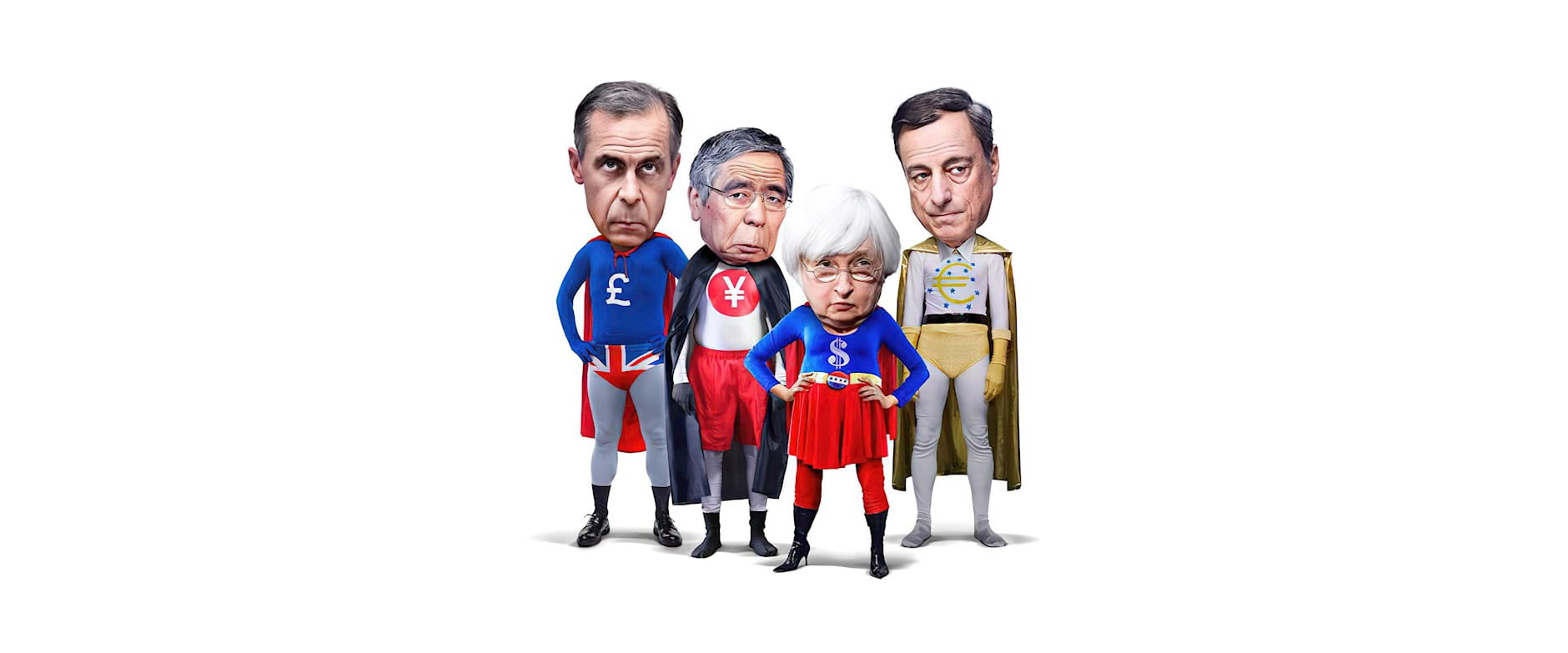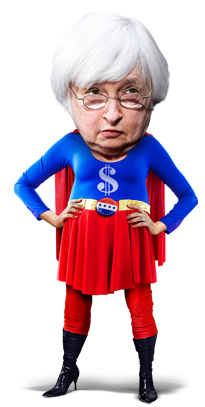
Why Criminal Defendants Should Choose Their Judges
A study of South Carolina data finds that ‘judge shopping’ could lead to more consistent sentencing.
Why Criminal Defendants Should Choose Their Judges
Henry Jansen
The heads of the world’s biggest central banks hold a place today like few others in modern history. As stewards of their institutions over the past decade, they’ve overseen a gigantic experiment in monetary policy—turning to largely untested policies in the midst and wake of a financial crisis.
In a five-month period in 2008, several large US financial institutions failed, the mortgage-backed securities market seized up, and the Dow Jones Industrial Average recorded its biggest one-day point drop in history.
While the Dow’s 7 percent fall on September 29 was far less painful than Black Monday’s nearly 23 percent fall in 1987, the gradual slump that followed led to comparisons to the Great Depression and other difficult episodes in US financial history—and pain reverberated through international markets.
Central bankers’ reaction was conventional, at first. The US Federal Reserve cut its target federal funds rate, the rate at which big banks lend money to each other overnight. In normal times the Fed would do that to make it cheaper for companies and consumers to take out mortgages or lines of credit, which should in turn inspire businesses and consumers to borrow and spend.
But these were not typical times. Banks that had made risky loans faced liquidity crises, and banks became much more discriminating in offering credit. The most solid of consumers and businesses could still borrow, but companies with less than near-perfect credit found themselves fighting individual crises as the credit they needed to conduct ordinary daily operations dried up. The 2008 financial meltdown sent the fed funds rate to nearly zero, leaving the Fed unable to cut further.
So central bankers departed from their daily scripts and dove into crisis mode.
Absent big disruptions such as wars or rampant inflation, central banks in functional economies tend to focus on keeping unemployment low and prices stable. But central banks were created largely to halt banking runs and calm financial panics. To stabilize the financial system and economy this time, central bankers adopted two largely untested monetary policies: they bought up large quantities of bonds and other assets to prop up market prices, and they embraced “forward guidance,” the practice of issuing carefully worded announcements about potential interest-rate changes, meant to encourage companies and consumers to spend money—and boost the economy.
The bankers had little research to back up their actions. For example, Fed governors “knew they could stimulate the economy by manipulating consumers’ expectations, but it wasn’t clear how to do that,” says Alexander W. Richter of the Federal Reserve Bank of Dallas.
Since then, he and others have gathered data to assess central banks’ performance, and the research is beginning to coalesce. The findings are shaping lessons about how, if, and when such policies reinvigorated struggling economies.
Did asset purchases stave off disaster? Did forward guidance drive down long-term interest rates and inspire investment? Beyond that, did central bankers save the global economy? And now, a decade on, are central bankers still relevant? The answers to these questions are not exactly what some researchers expected—and indicate a shift in attitudes about central bankers and monetary policy.

The US fed funds rate got stuck at the rarely seen territory near 0 percent at the end of 2008, and that would persist through 2015. At this “zero lower bound,” standard economic models of monetary policy made strong, and as it turned out highly inaccurate, predictions about what would happen next. As a result, it became hard to know what effects, if any, policy actions would have.
Conventional wisdom holds that the Fed can influence interest rates, and by extension the greater economy, through the federal funds rate. Most economists think changes in the fed funds rate affect the real (after-inflation) rates that matter to people deciding whether to, say, take out a mortgage to buy a home. By this view, the federal funds rate influences the amount of credit banks offer to consumers and businesses—and decisions on how pricey to make credit also affect the amount people and companies decide to borrow. But with 0 percent interest rates, central bankers couldn’t use rate cuts to spark growth.
Some prominent economists suggest that central bankers’ power is overblown. Chicago Booth’s Eugene F. Fama finds that the Fed must follow the markets’ lead when setting its target. In his view, interest rates are governed above all by supply and demand, and they fall because more people want to save than borrow, not because the Fed pushed them down. There can be large spreads between the fed funds rate and market rates, as banks lend at rates other than what the Fed is encouraging, he points out.
Other economists remain more confident in the Fed’s ability to influence rates, but there was uncertainty and great controversy about how to calculate the effects of Fed actions at the zero lower bound. Traditional economic models forecast that with rates at zero, deflation would spin out of control. And the popular New Keynesian models, which central banks had been using to guide policy, spit out baffling predictions. The models implied that disasters are good for economic growth. They predicted that telling consumers that prices would rise in 100 years would get more people to shop tomorrow than promising the same price hike would happen next month.
According to these results, “everything you think you know about economics is wrong,” says Stanford’s John H. Cochrane, also a distinguished senior fellow at Chicago Booth and a prominent skeptic of the New Keynesian approach. “Promises farther into the future work better than promises closer to today. Deliberately breaking things is good for the economy. And as you make the underlying problems better—for example, if you make prices and wages less ‘sticky’—things get worse.”
Terrible events such as natural disasters are great for economic growth, according to the New Keynesian models. But data refute the irrational results: in 2014, University of California at San Diego’s Johannes Wieland used data from the disastrous 2011 earthquake in Japan as well as a series of oil-price spikes across time to demonstrate that many of the usual rules of economics hold even at the zero lower bound. Such disasters, he finds, are followed by lower output, not output booms. This and similar work was critical to central bankers, identifying and providing empirical evidence of instances where the New Keynesian and other models broke down.
To get around the problems encountered at the zero lower bound, many of the researchers studying this time period have produced economic models designed to correct the issues that create counterfactual results. One of the most popular solutions has come out of work by Chicago Booth’s Jing Cynthia Wu and the Bank for International Settlements’ Fan Dora Xia, who performed the research as a graduate student at the University of California at San Diego.
In 2014, Wu and Xia posted research suggesting that where some models typically use the fed funds rate, economists should instead plug in a shadow rate when the fed funds rate hits zero. The research suggests that a shadow rate could provide information about the unconventional measures the Fed was taking, when the constant fed funds rate was not providing that information.
Wu and Xia used a shadow rate to help measure how macroeconomic quantities such as unemployment figures responded to unconventional policy tools, an insight that made their shadow rate particularly useful to, and used extensively by, the Fed and other central banks looking for ways to stimulate the economy. Now many economists use the Wu-Xia shadow rate in their macroeconomic models.
As a straightforward fix for any evaluations involving a low-interest-rate environment, the shadow rate will live long as a research tool, Wu predicts. “Fifteen years later, we’re still going to use the data at the zero lower bound,” she says. “For sure for the next 20 or 30 years.”
With help from the shadow rate, economists were able to assess central bank actions.

Central banks employed two unconventional policies, the first being quantitative easing. Seeing major financial institutions weakened and unemployment rising quickly, the US Federal Reserve spent trillions of newly created dollars (reserves) on bonds and other assets to prop up market prices. Its counterparts in the United Kingdom, Europe, and Japan went on comparable buying sprees. Asset-buying programs that few central bankers had ever experienced before 2008 became, during and after that year, the Fed’s weapons of choice, and a favored tool for keeping markets in order, depression at bay, and unemployment from soaring—or at least the central banks say so.
The ideas behind monetary manipulation, even unconventional manipulation, are elementary enough. Buying bonds may lower borrowing costs so that companies have capital for growth—and that growth turns into jobs for consumers, who in turn have money to spend. But for much of the past decade, no one was certain how quantitative easing would actually affect the economy. Research now suggests that easing had an effect, but also that the effect wore off. And quantitative easing may have exacerbated and prolonged deflation, rather than causing inflation as many economists had expected.
The Fed’s experiments with quantitative easing
Uncertain of how it would affect the ecomony, the Federal Reserve in 2008 began buying market assets to prop up prices.
The University of Southampton’s Richard A. Werner first used the term quantitative easing in the early 1990s to describe a program in which a central bank buys unconventional assets, such as long-term bonds and commercial paper, in the open market. Japan, which fell into a deep economic downturn in 1991, first tried it in 2001 with a round of government-bond purchases. That buying didn’t come to much and failed to ignite economic growth.
The Fed in November 2008 began its version of easing—buying mortgage-backed securities, agency debt, and long-term Treasury securities. In 2009, central banks in Europe and the UK launched their variations on this theme.
In the US, the first round of easing, QE1, ended on March 31, 2010, but the economic situation still looked bleak. Banks were hoarding reserves instead of lending, complaining that businesses didn’t have enough customers and consumers didn’t have enough earnings or assets to qualify for loans. So the Fed launched QE2 in November 2010.
With QE2 and then QE3, which began in September 2012, the Fed “simply bought long-term Treasuries whose prices were already higher than they’ve ever been in your or my lifetime,” says Cochrane. “They also bought mortgage-backed securities that were government backed, with interest rates lower than they’ve ever been.”
In 2011 and 2012, the Fed sold short-term Treasuries to take on even more long-term government bonds, in what became known as Operation Twist. QE3 involved more government long-bond and mortgage-backed securities purchases, and marked the final round of quantitative easing. That ran through October 2014. Quantitative-easing purchases swelled the Fed’s portfolio to some $4.5 trillion by the end of easing, compared to about $800 billion in 2007.
Experts deduced fairly quickly that QE1 accomplished its goal of reducing bond yields. But as job growth, wages, and consumption grew stagnant across the US, the question became: So what if yields were lower—were they creating additional business?
Booth’s Wu remembers attending conferences some years into the recession, when “QE was under way, but [Fed governors] had no idea of how much they should do or what the impact would be. They were making an educated guess,” says Wu. “They urged economic researchers to look at that issue quantitatively to give them more comfort.” It took time, but researchers obliged.
By 2012, many economists and quantitative studies declared QE1 had been an important factor in rescuing America’s crippled economy. In addition to academic and Fed studies, research out of the International Monetary Fund and the European Central Bank finds QE1 was highly effective in calming markets and lowering debt yields. Despite the findings in support of QE1, however, the US economy spent seven years after QE1 at or near recession, with nearly negative interest rates that typically indicate precarious job prospects and restricted wealth.
About QE2 and QE3, the research conclusions and opinions are less united. Research published by the San Francisco Fed finds that QE2 marginally bumped economic growth in 2010, adding 0.13 percentage points to real GDP growth. And Wu finds that by December 2013, quantitative easing had made the unemployment rate 1 percent lower than it would have been otherwise.
But other studies cast doubt. When the Fed launched QE1, it did so over many warnings about its potential to spark out-of-control inflation. A decade later, these worries may seem laughable, with savings accounts collecting minimal interest; but they remain real to many.
Cochrane argues that QE2 and QE3 had little effect on the economy, saying the research consensus seems to be that what effect QE2 and QE3 did have was indirect—when the Fed made big actions, this served as a signal that the Fed would keep interest rates low for a very long time. He disputes the idea that the “few tenths of a percentage point” change in the interest rate on government bonds that the Fed achieved from buying riskier securities could have had any lasting impact on the overall interest rates and thereby the economy.
Research from the Bank for International Settlements, an institution owned by the world’s central banks, backs that sentiment. The study finds that Fed bond purchases after the 2008 financial meltdown had “no statistically significant real impact” on economic activity, despite their effect on interest rates.
America’s relative success in escaping recession has caused some to look charitably on the Fed’s quantitative-easing program. The US economy today is better off than the economies of the European Union and other countries that practiced less-aggressive easing. But is that due to quantitative easing, or to something else? There’s waning faith that easing is responsible.

The art of word craft has become an instrumental tool for promoting economic recovery. During the recession, all the big central banks started using forward guidance in ways meant to encourage spending by both consumers and corporations.
Some of the holiest words on Wall Street—especially when interest rates were trapped near zero—came in the form of almost meaningless phrases from the Federal Reserve. “For some time,” “for an extended period,” and other nebulous idioms peppered the Fed’s statements, which were intended to stimulate the US economy by indicating low interest rates would come in the future. No one knew how to translate these phrases into a date or even a season when interest rates would change, yet investors and corporations valiantly scrutinized the announcements for actionable messages. The wording at one point in 2011 of “at least through mid-2013” may have squelched more than one company’s round of layoffs, or prompted hiring offers.
Or it might not have, and this is the question economists are debating. Despite the sometimes extraordinary attention market participants paid to these Fed utterances, did forward guidance have a noticeable or lasting effect on the actual economy?
Some research suggests that forward guidance is a key stimulus tool, but to be used with care and caution.
Long before 2008, in the high-interest-rate days of the 1980s, then Federal Reserve Chair Paul Volcker calmed fears by laying out steps the Fed would take to bring down inflation. But he didn’t give predictions or specific actions the Fed might take, and he even denied that the Fed tried to control interest rates.
So when some central banks began publishing their official, longer-term rate projections, it was controversial. The Reserve Bank of New Zealand began using forward guidance in 1997, Norway’s Norges Bank started in 2005, and Sweden’s Riksbank started in 2007. The Federal Open Market Committee experimented with forward guidance between 2003 and 2006, and guidance was hailed in some economics circles as a move toward more transparency.
Ideally, when the Fed indicates or even promises low rates, businesses expand, hire, and fuel a healthy economy on the expectation of cheap credit. Loans remain cheap or get cheaper across the spectrum—for mortgages, lines of credit, car loans, and any other borrowing with an interest rate attached. Additional Fed communication, whether vague statements or more specific guidance that portends policy makers’ thinking about short-term interest rates, is meant to give investors confidence in central bankers and the economy.
But when the financial crisis hit, central bankers embraced communication as a stimulus tool. The Fed paired forward guidance in December 2008 with the first quantitative-easing program by cutting the already-low fed funds rate and promising to keep it near zero “for some time.” Bankers in Europe, the UK, and other developed economies adopted similar versions of forward guidance.
At the zero lower bound, bankers were in uncharted waters. The events were unprecedented, and therefore the Fed and other central banks had very little research to guide precise policies. New Keynesian economic models predicted that forward guidance would produce wildly positive results, particularly if the Fed promised that rates would remain low decades into the future, as opposed to staying low for just a year or even a few months. The results, although difficult to prove bogus, were hard for economists to take seriously, says Chicago Booth’s Joseph S. Vavra. The affront to common sense left the Fed with little evidence to support its method of choosing what messages it should broadcast to the public.
“When you look at all the different language that they used—and they used anything from the most vague statements that you can have to statements that were quite precise—it’s clear that a lot of this was sort of ‘seat of the pants,’” says Federal Reserve Bank of Dallas’s Richter, who has made Fed communication a specialty. He says that despite the lack of clear evidence, the Fed acted thoughtfully and intentionally. That said, he finds several ways the guidance could have been more effective.
To have an impact, an announcement needs to include news, he says, not something markets already know. Central bankers should also be careful of offsetting a confident message about rate intentions with “commentary about how the economy isn’t as good as we thought,” says Richter, who finds that the Fed may have undercut its mission by routinely recapping the state of the economy within the same meeting notes that served as forward-guidance announcements.
It can be fine for the Fed to comment on the state of the economy in some cases, but if the Fed is trying to guide investors into expecting higher interest rates, saying the economy is weaker than thought can dampen investors’ expectations. Since the commentary on economic conditions was generally pessimistic, Richter says, this overshadowed any reassuring message that the Fed was trying to convey about holding down interest rates. “If you devote one paragraph to forward guidance, but another to commentary about how the economy isn’t as good as we thought, we’re pessimistic about the future,” he says. “That’s going to offset any gains that you potentially had” with forward guidance.
And he argues that the wording should include the specific timing of interest-rate changes. The Fed, he says, stimulated the economy whenever announcements were more specific. In December 2008, the Fed promised “likely” low rates “for some time.” In August 2011 it began using date-based forward guidance, and the following month the FOMC announcement promised exceptionally low interest rates “at least through mid-2013.” According to Richter, this had a significant effect in lowering current and future interest rates.
The least ambiguous time frames are probably the most stimulative, says Richter. The Fed likely lost much of the potential effect of forward guidance early on by keeping the timing of interest-rate changes vague, he says: “When you look back, knowing how bad the recession was, how long the economic downturn lasted, I think it’s pretty clear that we should have used stronger language and used it earlier.”
Fed attaches dates to forward guidance
After the Fed’s 2011 announcement that it intended to keep the fed funds rate low “at least through mid-2013,” forward rates fell significantly. But later statements extending that time horizon to “late 2014” and then “mid-2015” had less of an effect.
Quarter-over-quarter real GDP growth forecasts
The Fed’s statements may have made little impact on GDP forecasts.
*Downward revision of GDP on July 29, 2011—in between growth forecasts—complicates assessments of Fed’s Aug. 9 statement
Keen et al., 2017
However, Columbia University’s Michael Woodford, a longtime advocate for the use of forward guidance, argued that guidance tied to economic outcomes would be superior to any based on a specific but relatively faraway date. In discussions with and presentations to Fed officials, he stressed the importance of setting a target for a nominal variable such as GDP. And when the FOMC met in December 2012, the Fed described its next interest-rate movement as tied to unemployment and inflation targets—although it tied forward guidance to the real employment rate, not the nominal variables Woodford favored.
And a separate research group cautions that time-based guidance—such as “We expect rates to remain low through mid-2015”—could distract investors from more important data. A paper presented at the US Monetary Policy Forum, run by Booth’s Initiative on Global Markets, analyzes 20 years of Fed communications. It finds that in the post–financial crisis years, from 2011 to 2015, the Fed moved toward offering strong hints about the calendar timing of potential rate hikes. That has led investors to discount macroeconomic events, and their inattention to those ultimately undermines the Fed’s mission of optimal monetary policy, according to the researchers.
Time-based guidance tends to overshadow any data-based qualifications and the broader message, they argue. It can also lead to credibility issues if the data don’t pan out as expected and rate changes need to be delayed or sped up. Reneging on a promise can kill any chance of forward guidance being effective in the future. Japan learned this the hard way, having changed its announced plans so often that many market and economic experts no longer consider its guidance credible.
The researchers—Michael Feroli of J. P. Morgan Chase, David Greenlaw of Morgan Stanley, Peter Hooper of Deutsche Bank Securities, Frederic Mishkin of Columbia University, and Chicago Booth’s Amir Sufi—conclude that time-based guidance is appropriate when the Fed is out of options. But they argue that these conditions do not describe the current situation in the US, and that the Fed should drop time references and return to more-data-driven guidance. (For more, see “Note to Yellen: Knock off the time-based guidance.”)
Despite Richter’s conclusions that forward guidance can be effective in certain circumstances, he and many other researchers are unconvinced that it had a major effect on the economy in the aftermath of the Great Recession. “I don’t have a sense that forward guidance is harmful, but I don’t think it has had huge positive effects either,” says Chicago Booth’s Vavra.
Cochrane is suspicious of the idea that the actual economy moves on the promises of any Fed chair to do things in the far future. “The idea that the average American reads [Fed Chair] Yellen’s promises about what she’s going to do five years from now and changes his or her behavior? That seems pretty far-fetched,” says Cochrane. As for the bond traders and corporate finance folks who plan their days around Yellen’s words, Cochrane contends that it’s not economically useful for the Fed to create volatility in markets.
Whatever is wrong with the economy today—and opinions vary widely—many economists agree that it’s not a problem monetary policy can fix.
Senior Fed Economist Taisuke Nakata explains some objections to forward guidance in FEDS Notes, a series of articles on the Federal Reserve Board’s website. If the Fed commits to keeping interest rates low for an extended period, as strong forward guidance requires, it may encourage enough economic activity to push inflation beyond Fed targets, Nakata writes. Overshooting can later have harsh consequences throughout the economy, according to the paper. The Fed would then have a significant incentive to raise rates earlier than it led the public to expect. Many Fed officials have pointed out that reneging on any promise regarding rates creates a credibility gap that leads the public to discount later forward guidance.
As an alternative, some experts back more of a mundane communications policy that simply reassures the public that the Fed will continue to follow its mandates: maximizing employment, stabilizing prices, and moderating long-term interest rates. Says Cochrane, “A much calmer, more rules-based monetary policy, and much less speechifying about what’s going to happen, would be more effective.”

It’s been almost a decade since the financial system swooned and, by some accounts, unconventional monetary policy stepped in and prevented even greater calamity. University of Texas at Austin’s Saroj Bhattarai and St. Louis Fed’s Christopher Neely looked at the research on the effects of the Fed’s strategies since 2008 and find that quantitative easing and forward guidance had strong, intended effects on bond yields, exchange rates, and asset prices. Theoretically, these changes lead to sustained economic growth.
But even now, the US economy is still struggling to grow. Whatever is wrong with the economy today—and opinions vary widely—many economists agree that it’s not a problem monetary policy can fix.
One possible reason: Vavra finds that monetary-policy actions are less powerful during deep recessions than in healthier times. In practice, that means the Fed should lower its expectations about how much its actions can lead to higher employment or consumption. Vavra says that traditional modeling misses this important caveat because it tends to estimate the “average economy” over an era that typically includes big swings in economic health. But “we are not usually trying to stimulate the average economy,” he says. People care much more about policy effects during recessions. After all, booming economies don’t need much of a push from central bankers.
His research finds that stimulus actions by central banks are less effective during economic downturns than they are in boom times (when less needed), and he voices a common belief that the Fed’s efforts had diminishing returns.
Research studies on the era have reshaped opinions on unconventional monetary tools. Experience and data from the past eight years have helped build favor for a narrower role for monetary policy.
“A lot of people thought [monetary policy] was a cure-all, and it isn’t,” says Chicago Booth’s Randall S. Kroszner, a Fed governor from 2006 to 2009. “It is one necessary piece to avoid a wrenching deflation. In and of itself, it is not sufficient to ensure economic growth.”
Arguments about the power of monetary policy and central banks go back centuries. That bad monetary policies can disrupt business is well established, but just how much and for how long can active monetary policies promote growth? The past decade is leading some to change their positions and the view they have of central-bank policies. There was a time when central bankers were rock stars—in some circles, former Fed Chairman Alan Greenspan received adulation comparable to that given Bruce Springsteen. Now many say that central bankers can address crises and painful but temporary business cycles, but not problems that last for nearly a decade. This view depicts central bankers whom some might consider humbler, perhaps with a diminished sense of influence, and who recognize the limits of their power. Central bankers might be able to spur “demand,” but they can’t improve “supply.”
There’s one way in which the Fed did save the US economy: it didn’t cause a second Great Depression. Many Americans lived through a painful recession in which they lost homes, jobs, and hope, but the situation wasn’t as dire as it had been 80 years earlier. In 2009 at the low point of the recent crisis, GDP registered 4 percent lower than at its 2007 peak. In the Great Depression, GDP fell precipitously for three years, ending in 1933 about 25 percent lower than in 1929.
Still, research finds there are limits to what central bankers can achieve. The Fed’s actions in late 2008 certainly kept the recession from becoming much worse, but the economy didn’t really revive. Growth has stalled around 2 percent. Central banks can help to avoid Great Depressions, but research indicates their power to boost growth may be muted when needed most.
Having spent the better part of a decade interpreting the effects of unconventional monetary policy, some economists have turned their attention to finding ways governments can encourage growth without relying on monetary policy at all. Stimulus talk now focuses more on structural changes to things such as tax policies and various regulations that encourage or discourage working, hiring, and investing. “We can fight the deflation, but you have to have structural reform policies to try to revive economic growth,” says Kroszner. Central bankers can do only so much.

A study of South Carolina data finds that ‘judge shopping’ could lead to more consistent sentencing.
Why Criminal Defendants Should Choose Their Judges
Economic experts consider what a nationwide ban on the app would mean for innovation and for the rest of the tech industry.
What Would Banning TikTok Mean for the US Economy?
Economists consider to what degree network effects will help Twitter as some users grow concerned about the platform.
Will Twitter’s Size Protect It from Defections?Your Privacy
We want to demonstrate our commitment to your privacy. Please review Chicago Booth's privacy notice, which provides information explaining how and why we collect particular information when you visit our website.